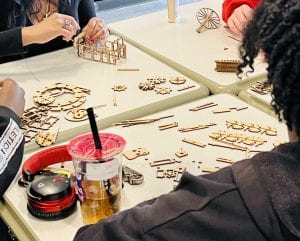By Rachita Ramya
Instructor, Creative Writing and Literature
rachita.ramya@stonybrook.edu
As a creative writing and literature teacher, I find myself in a unique position, having grown up in India and now teaching undergraduate students at Stony Brook University. My first language, Hindi, gifts me with a strong Indian accent when I speak English, and I fear that my words may be misunderstood by my students. At times, I worry that some students may wonder why an Indian woman is teaching Creative Writing & Literature in English. To address these concerns, I’ve designed a more inclusive syllabus that features stories and essays from writers of different countries, races, and backgrounds. My course, “Everyone has a story, let’s find yours,” helps students explore their voice through writing and tell their important stories. In class, we read stories from all over the world, including translated texts. Over time, I’ve realized that good stories don’t need to be written in a specific language to be considered good. The best stories transcend language and vocabulary limitations.

In our class discussions about Arundhati Roy’s essay, “What is the morally appropriate language to think & write?” my students have diverse opinions. They often relate to the idea that we’re not always understood by even people who speak the same language as us. Surprisingly, about a quarter of the class is multilingual. They’re amazed when I share that the language of storytelling is not as crucial as evoking universal emotions and interest.
To overcome language barriers in storytelling, I introduced wooden blocks from MuBaBaO into our creative journey. Originating from Poland, these wooden blocks, also known as creative thinking blocks, were brought to us by the distinguished storyteller Michal Malinowski, who uses them in his own classroom while teaching undergraduate students at the University of Krakow. Prior to that, Michal employed these blocks with war refugees from Ukraine, who found it easier to articulate their experiences using building blocks rather than struggling with broken words and sentences. In Michal’s own words, ‘the blocks serve as a vehicle for storytelling, an instrument to make sense out of the chaos and create something out of nothing.’
When used in my class, the blocks sparked my students’ imagination. They built intricate structures like spaceships, bicycles, basketball courts, carriages, and houses. Each creation had a unique story behind it, reflecting the individuality of its creator. Even reserved students opened up and shared their creations. This exercise went beyond storytelling; it became a form of problem-solving and an exercise in critical thinking and communication. It reminded me that stories have historically been a way to address complex challenges. What’s remarkable is the impact these blocks have beyond the classroom. They create a means for interaction and collaborative artwork within the community.

Exploratory studies with similar blocks showed that they can help learners understand course concepts, experience group dynamics, and build communication skills (Allen et al., 2009, Auvinen et al., 2013, Rick et al., 2005, Roos et al., 2004, Roos et al., 2018, Peabody et al., 2018). This visual approach to storytelling engages participants in dynamic and multi-layered exercises, fostering creative thinking, spatial intelligence, and effective communication. It adds depth by requiring participants to narrate a story related to their creation, including considering solutions to real-world challenges. These blocks can act as a universal language, uniting people from diverse backgrounds through the shared language of imagination and expression. They can also be applied in various fields to enhance organizational and leadership skills. Together, we can embark on a journey of discovery and growth, learning to appreciate the depth and power of storytelling beyond spoken words, and embracing the beauty of diverse voices in literature.
References:
- Allen, S. J. and Hartman, N. S. (2009), “Sources of learning in student leadership development programming”, Journal of Leadership Studies, Vol. 3, No. 3, pp. 6-16. https://doi.org/10.1002/jls.20119
- Auvinen, T., Aaltio, I. and Blomqvist, K. (2013), “Constructing leadership by storytelling- the meaning of trust and narrative”, Leadership and Organization Development Journal, Vol. 34, No. 6, pp. 496-514. https://doi.org/10.1108/LODJ-10-2011-0102
- Rick, J., & Lamberty, K. K. (2005). Medium-based design: Extending a medium to create an exploratory learning environment. Interactive Learning Environments, 13(3), 179–212. https://doi.org/10.1080/10494820500401883
- Roos, J., & Victor, B. (2018). How It All Began: The Origins Of LEGO® Serious Play®. International Journal of Management and Applied Research, 326–343. https://doi.org/10.18646/2056.54.18-025
- Roos, J., Victor, B., & Statler, M. (2004). Playing seriously with strategy. Long Range Planning, 37(6), 549–568. https://doi.org/10.1016/j.lrp.2004.09.005
- Peabody, M. A., & Turesky, E. F. (2018). Shared leadership lessons: Adapting LEGO® SERIOUS PLAY® in higher education. International Journal of Management and Applied Research, 5(4), 210-223.
